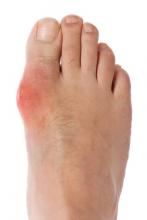The prevalence of gout has increased in the United States, especially among the eldest population, according to the latest national data. That means that nursing home staff are caring for more hot, swollen, and inflamed joints than ever, said several experts on the topic.
In interviews, they added that clinicians’ potential success in preventing, diagnosing, and treating the disease in long-term care residents lies largely in fundamental practices and an individualized approach to medications.
Data from the National Health and Nutrition Examination Survey (NHANES) show an increase in gout prevalence among U.S. adults from 2.7% in the survey’s 1994-1998 reporting periods to 3.9% in 2007-2008. Meanwhile, the prevalence in adults aged 80 years and older jumped from 5.9% to 12.6%.
The prevalence of hyperuricemia, which usually precedes gout, was 31% in adults aged 65 years or older and 37% among those aged 80 years and older, according to the latest NHANES data. The increase in actual gout occurred mainly among men in NHANES. Other studies, however, have documented an increased prevalence of the disease among older women as well. Studies cited in a review of "Crystal-Associated Arthritis in the Elderly" showed women making up at least half of the cases in which gout first strikes after age 60 years. Among individuals who have a first episode after age 80, women seem to predominate (Rheum. Dis. Clin. N. Am. 2007;33:33-55).
The presentation of the disease, as well as its prevalence, is changing, said Dr. Arthur Weinstein, professor of medicine at Georgetown University Medical Center and director of rheumatology at Washington Hospital Center. "We’re seeing more and more polyarticular gout in older patients, for instance, either as an initial presentation or years after just a single monoarticular episode" with no subsequent recurrences, said Dr. Weinstein in an interview.
He and others said they believe that the common use of thiazide diuretics in older patients is a major driver of gout’s changing profile. Other factors could include genetic predispositions to hyperuricemia and gout and increasing obesity, insulin resistance, and metabolic syndrome in the aging population.
While often the best choice for hypertension management, thiazide diuretics can contribute to the development of chronic hyperuricemia, as can low-dose aspirin and cyclosporine. Also, increasing numbers of elderly people have chronic cardiac and renal disease – factors that have been associated with hyperuricemia and gout.
Other changes in gout’s presentation in the elderly include earlier and often-atypical development of the soft tissue masses known as tophi and more frequent and earlier involvement of the small joints of the fingers.
Diagnosis, Empiric Therapy
The differential diagnosis of a swollen, inflamed joint often involves ruling out the likelihood of septic arthritis, fracture, or other injury, and pseudogout – the other main form of crystal-induced arthritis.
Patients experiencing an acute gout attack can have a low-grade fever. "But with a fever of 101 or higher, you have to consider that it’s something that’s not crystal induced," said Dr. John W. Rachow, a geriatrician and rheumatologist at the University of Iowa, Iowa City.
Septic arthritis should also be suspected when patients have joint pain and tachycardia, hypotension, or signs of other acute illness. "And if there is hardware in the joint, even without a fever, patients should be evaluated at a higher level," said Dr. Rachow, who also serves as an attending physician in numerous nursing homes in the Iowa City area.
While the diagnostic standard for gout – synovial fluid or tophi aspiration with the identification of monosodium urate crystals under polarizing microscopy – can seem even more important in the older population, it is also more untenable given the stresses of transporting nursing home patients to hospitals.
A good long-term care mindset can preclude the need for crystal diagnosis in every case, said clinicians interviewed for this story.
"In health care, we tend to turn things into acute episodes when they’re really acute exacerbations of chronic conditions," said Dr. George Taler, director of long-term care in the department of medicine at the Washington Hospital Center and medical director of the Capitol Hill Nursing Center, both in Washington.
"Diagnosing and treating gout successfully "means remembering that our patients have a history," said Dr. Taler. He advised "making sure that when the nurse calls about a swollen knee, he or she has reviewed the medical record."
A host of factors can indicate the likelihood that joint pain is a gout attack. These include a history of gout, persistent elevated uric acid levels, and the use of medications or existence of medical conditions associated with gout. Blood testing at the time of an attack is not informative, said Dr. Rachow. While most patients with gout have chronically elevated uric acid levels, serum uric acid levels at the time of an attack are frequently normal, he explained.


